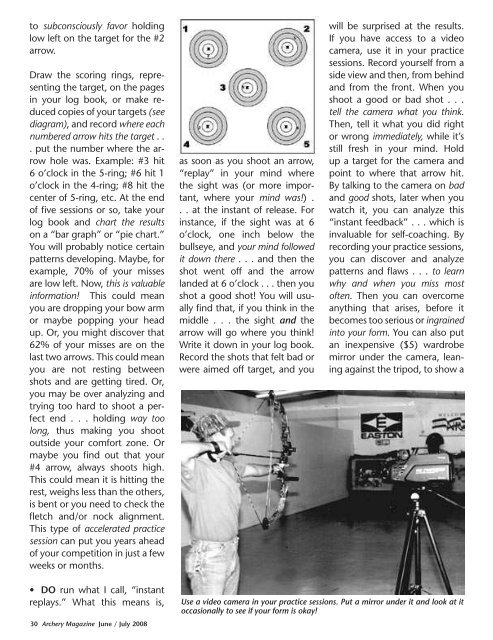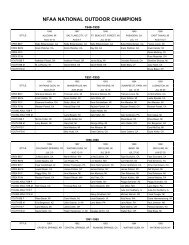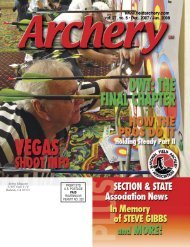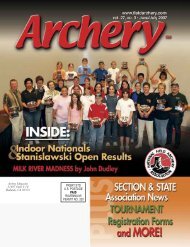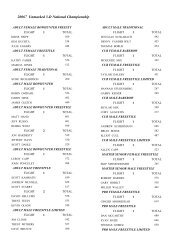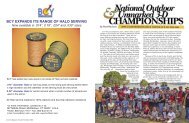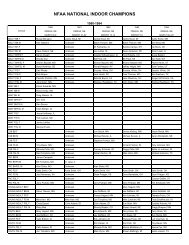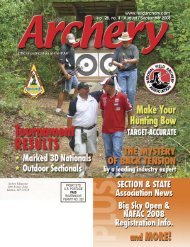the 2008 national indoor results - National Field Archery Association
the 2008 national indoor results - National Field Archery Association
the 2008 national indoor results - National Field Archery Association
You also want an ePaper? Increase the reach of your titles
YUMPU automatically turns print PDFs into web optimized ePapers that Google loves.
to subconsciously favor holding<br />
low left on <strong>the</strong> target for <strong>the</strong> #2<br />
arrow.<br />
Draw <strong>the</strong> scoring rings, representing<br />
<strong>the</strong> target, on <strong>the</strong> pages<br />
in your log book, or make reduced<br />
copies of your targets (see<br />
diagram), and record where each<br />
numbered arrow hits <strong>the</strong> target . .<br />
. put <strong>the</strong> number where <strong>the</strong> arrow<br />
hole was. Example: #3 hit<br />
6 o’clock in <strong>the</strong> 5-ring; #6 hit 1<br />
o’clock in <strong>the</strong> 4-ring; #8 hit <strong>the</strong><br />
center of 5-ring, etc. At <strong>the</strong> end<br />
of five sessions or so, take your<br />
log book and chart <strong>the</strong> <strong>results</strong><br />
on a “bar graph” or “pie chart.”<br />
You will probably notice certain<br />
patterns developing. Maybe, for<br />
example, 70% of your misses<br />
are low left. Now, this is valuable<br />
information! This could mean<br />
you are dropping your bow arm<br />
or maybe popping your head<br />
up. Or, you might discover that<br />
62% of your misses are on <strong>the</strong><br />
last two arrows. This could mean<br />
you are not resting between<br />
shots and are getting tired. Or,<br />
you may be over analyzing and<br />
trying too hard to shoot a perfect<br />
end . . . holding way too<br />
long, thus making you shoot<br />
outside your comfort zone. Or<br />
maybe you find out that your<br />
#4 arrow, always shoots high.<br />
This could mean it is hitting <strong>the</strong><br />
rest, weighs less than <strong>the</strong> o<strong>the</strong>rs,<br />
is bent or you need to check <strong>the</strong><br />
fletch and/or nock alignment.<br />
This type of accelerated practice<br />
session can put you years ahead<br />
of your competition in just a few<br />
weeks or months.<br />
• DO run what I call, “instant<br />
replays.” What this means is,<br />
as soon as you shoot an arrow,<br />
“replay” in your mind where<br />
<strong>the</strong> sight was (or more important,<br />
where your mind was!) .<br />
. . at <strong>the</strong> instant of release. For<br />
instance, if <strong>the</strong> sight was at 6<br />
o’clock, one inch below <strong>the</strong><br />
bullseye, and your mind followed<br />
it down <strong>the</strong>re . . . and <strong>the</strong>n <strong>the</strong><br />
shot went off and <strong>the</strong> arrow<br />
landed at 6 o’clock . . . <strong>the</strong>n you<br />
shot a good shot! You will usually<br />
find that, if you think in <strong>the</strong><br />
middle . . . <strong>the</strong> sight and <strong>the</strong><br />
arrow will go where you think!<br />
Write it down in your log book.<br />
Record <strong>the</strong> shots that felt bad or<br />
were aimed off target, and you<br />
will be surprised at <strong>the</strong> <strong>results</strong>.<br />
If you have access to a video<br />
camera, use it in your practice<br />
sessions. Record yourself from a<br />
side view and <strong>the</strong>n, from behind<br />
and from <strong>the</strong> front. When you<br />
shoot a good or bad shot . . .<br />
tell <strong>the</strong> camera what you think.<br />
Then, tell it what you did right<br />
or wrong immediately, while it’s<br />
still fresh in your mind. Hold<br />
up a target for <strong>the</strong> camera and<br />
point to where that arrow hit.<br />
By talking to <strong>the</strong> camera on bad<br />
and good shots, later when you<br />
watch it, you can analyze this<br />
“instant feedback” . . . which is<br />
invaluable for self-coaching. By<br />
recording your practice sessions,<br />
you can discover and analyze<br />
patterns and flaws . . . to learn<br />
why and when you miss most<br />
often. Then you can overcome<br />
anything that arises, before it<br />
becomes too serious or ingrained<br />
into your form. You can also put<br />
an inexpensive ($5) wardrobe<br />
mirror under <strong>the</strong> camera, leaning<br />
against <strong>the</strong> tripod, to show a<br />
Use a video camera in your practice sessions. Put a mirror under it and look at it<br />
occasionally to see if your form is okay!<br />
profile view of your form. As you<br />
come to full draw, peek out of<br />
<strong>the</strong> corner of your eye and look<br />
in <strong>the</strong> mirror at your form . . .<br />
are you leaning back? . . . is your<br />
elbow too low? . . . is your draw<br />
shoulder up or down? If you see<br />
something wrong . . . let down<br />
and start over! This will help you<br />
stop a lot of bad form before it<br />
takes hold, if you are willing to<br />
apply yourself.<br />
• DON’T pressure yourself into<br />
trying to beat <strong>the</strong> local “hot<br />
shot” or into trying to shoot a<br />
perfect 200 on a 3-D round, if<br />
your personal best is only 174.<br />
Only a fool expects to shoot<br />
twenty bullseyes in a row in a<br />
tournament, when he has never<br />
shot more than eight in a row in<br />
practice.<br />
• DO set realistic and attainable<br />
goals. You should have<br />
three types of goals. Your immediate<br />
goal should be to shoot<br />
only this one shot today . . . in<br />
<strong>the</strong> exact center of <strong>the</strong> target.<br />
Your intermediate goal should<br />
be to beat your previous best<br />
score. Your long term goal may<br />
to be to win <strong>the</strong> world championship<br />
. . . but that one is up to<br />
you! You should only compete,<br />
in any given tournament, with<br />
your last best score, not <strong>the</strong> local<br />
hero. Pay no attention to your<br />
competitor’s scores . . . you<br />
can’t change <strong>the</strong>m. The only<br />
thing worrying about <strong>the</strong>m will<br />
do is change your score! Your<br />
goal should be one point higher<br />
than your best previous effort!<br />
If you want to greatly improve<br />
your accuracy in <strong>the</strong> woods or<br />
at a tournament, <strong>the</strong>n you must<br />
be more astute, organized, analytical,<br />
and intense in your practice<br />
sessions than you’ve ever<br />
been in <strong>the</strong> past. Remember . .<br />
. “If you continue (in practice)<br />
to do what you’ve always done,<br />
you’ll get what you always got<br />
(in tournaments)!”<br />
Also, don’t forget<br />
<strong>the</strong> Rule of 6 P’s —<br />
Persistent Perfect Practice<br />
Prevents Poor Performance!<br />
You’ll get worse before you<br />
get better<br />
If you do decide to bear down<br />
and “take <strong>the</strong> cure,” remember<br />
this: you’ll get worse before you<br />
get better . . . accept it! Normally,<br />
it takes sixty to ninety days for<br />
your score to return to normal .<br />
. . and <strong>the</strong>n to steadily increase.<br />
The reason for that is, as you try<br />
parts of <strong>the</strong> new “idiot proof”<br />
form, each shot will be part your<br />
new way and part your old way.<br />
Until you totally ingrain <strong>the</strong> new<br />
form into your subconscious, it’s<br />
still not yours. That’s why we recommend<br />
not shooting a target .<br />
. . just an empty bale or a bow<br />
simulator. Gradually, <strong>the</strong> new<br />
form will completely replace<br />
your old way and you won’t<br />
even be able to remember how<br />
you used to do it. Don’t give up!<br />
Stick with it . . . it will pay off in<br />
<strong>the</strong> end. Just ask any of my students!<br />
Stay away from targets.<br />
They will only slow down or kill<br />
your progress. Remember, you<br />
can’t learn while you’re aiming.<br />
Insert picture “eyes closed”.<br />
Caption: Shooting with your<br />
eyes closed transfers <strong>the</strong> feeling<br />
into your muscle memory.<br />
Here’s an idea that a lot of pro<br />
shops and clubs have adopted<br />
that will help make empty bale<br />
shooting less boring. I call it<br />
“Empty Bale Night.” One night<br />
continued on pg. 32<br />
30 <strong>Archery</strong> Magazine June / July <strong>2008</strong> <strong>Archery</strong> Magazine June / July <strong>2008</strong> 31


